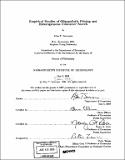| dc.contributor.advisor | Glenn Ellison and Nancy L. Rose. | en_US |
| dc.contributor.author | Sorensen, Alan T. (Alan Tad), 1972- | en_US |
| dc.date.accessioned | 2005-08-22T18:27:57Z | |
| dc.date.available | 2005-08-22T18:27:57Z | |
| dc.date.copyright | 1999 | en_US |
| dc.date.issued | 1999 | en_US |
| dc.identifier.uri | http://hdl.handle.net/1721.1/9451 | |
| dc.description | Thesis (Ph.D.)--Massachusetts Institute of Technology, Dept. of Economics, 1999. | en_US |
| dc.description | Includes bibliographical references (p. 97-100). | en_US |
| dc.description.abstract | This thesis consists of an examination of the role of consumer search in explaining price patterns in retail markets for prescriptions drugs {Chapters 1 and 2), as well as a separate study of hospital-insurer bargaining in the state of Connecticut (Chapter 3). Chapter 1 seeks to establish the empirical importance of price dispersion due to costly consumer search by examining retail prices for prescription drugs. Posted prices in two geographically distinct markets are shown to vary considerably across pharmacies within the same market, even after controlling for variation due to pharmacy differences. Pharmacy heterogeneity accounts for at most one third of the observed price dispersion. The empirical analysis hinges on the observation that consumers' incentives to price-shop depend on characteristics of the drug therapy. Cross-sectional patterns in price distributions across drugs are consistent with the predictions of a search model: prices for repeatedly purchased prescriptions (for which the expected benefits of search are highest) exhibit significant reductions in both dispersion and price-cost margins. The second chapter extends the analysis of prescription drug pricing by using detailed data on retail pharmacy transactions to make inferences about the nature and intensity of consumer search. Prescription prices exhibit patterns that should, in principle, induce search: in particular, prices vary widely across stores, and stores' price rankings are inconsistent across drugs (so that the low-price pharmacy is different for one prescription vs. another). Estimates from a model of pharmacy choice suggest that search intensities are generally low: I estimate that for a typical prescription, the fraction of consumers that price-shops is approximately .14. Variation in this estimated search intensity across drugs appears to be consistent with explanations based on rational search; for instance, price-shopping is more prevalent for maintenance medications than for one-time purchases. Comparisons of estimated search intensities with corresponding estimates of benefits imply that the cost of conducting a price-search is roughly $9.50 for the average consumer. Chapter 3 contains a separate study of hospital-insurer bargaining. I use unique data from the state of Connecticut to examine discounting patterns in the state's hospital industry for the years following deregulation (1994-1996). The data provide a rare opportunity to study payer level differences in negotiated discounts for hospital services. In addition to presenting descriptive evidence on how discounts vary across payers, payer types, and hospital types, this study uses matched revenue data to analyze the economic determinants of discount magnitudes. I find that HMOs negotiate discounts that are on average 14 percentage points larger than discounts received by traditional indemnity plans. Payers designated as PPOs negotiate discounts only 2-3 percentage points better than indemnity plans. Payer size appears to affect bargaining power, but the economic significance of the effect is rather small. The data are shown to exhibit patterns consistent with a bargaining explanation, in which discount magnitudes depend critically on payers' abilities to "channel" patients to hospitals with which favorable discounts have been negotiated. In contrast with the effects of payer size, the estimated impact of channeling ability on discount magnitudes is substantial. | en_US |
| dc.description.statementofresponsibility | by Alan T. Sorensen. | en_US |
| dc.format.extent | 100 p. | en_US |
| dc.format.extent | 8457113 bytes | |
| dc.format.extent | 8456869 bytes | |
| dc.format.mimetype | application/pdf | |
| dc.format.mimetype | application/pdf | |
| dc.language.iso | eng | en_US |
| dc.publisher | Massachusetts Institute of Technology | en_US |
| dc.rights | M.I.T. theses are protected by copyright. They may be viewed from this source for any purpose, but reproduction or distribution in any format is prohibited without written permission. See provided URL for inquiries about permission. | en_US |
| dc.rights.uri | http://dspace.mit.edu/handle/1721.1/7582 | |
| dc.subject | Economics | en_US |
| dc.title | Empirical studies of oligopolistic pricing and heterogeneous consumer search | en_US |
| dc.type | Thesis | en_US |
| dc.description.degree | Ph.D. | en_US |
| dc.contributor.department | Massachusetts Institute of Technology. Department of Economics | en_US |
| dc.identifier.oclc | 43433736 | en_US |
